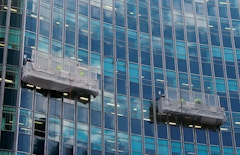
466 results
-
 Daylighting is a key strategy to energy efficiency and improved occupant comfort, health, and productivity in buildings. However, providing desired…
Daylighting is a key strategy to energy efficiency and improved occupant comfort, health, and productivity in buildings. However, providing desired… -

End-of-Life Challenges in Facade Design
- Paper by Rebecca Hartwell · Mauro Overend
In recent decades, there has been increased attention to reduce the operational energy performance of buildings. Stringent legislation on building
-

Impact Of Thermal Bridges On The Energy Response Of A Building
- Paper by Ilaria Sebastiani, Institute for Renewable Energy Riccardo Pinotti, Institute for Renewable Energy Stefano Avesani, Institute for Renewable Energy Simone D’Amore, Department of Structural and Geotechnical Engineering Stefano Pampanin, Department of Structural and Geotechnical Engineering
The European building stock is mainly constituted by highly energy demanding buildings. The only way to a more sustainable and decarbonized building… -

Vertical Louvered Solar Control
- Paper by Clifton Fordham, RA, LEED AP,
Exterior shading devices, when typically used, are horizontal planes that are most effective at the south face of buildings in the northern… -

Let Thin Glass in the Facade Move
- Paper by Prof. DI Dr. Jürgen Neugebauer, DI Dr. Markus Wallner-Novak,
Facades play an important role in the control of energy flow and energy consumption in buildings as they represent the interface between the outdoor… -

Low-Carbon Cladding and Shading Design
- Paper by Prateek Jain, LEED, Senior Environmental Designer Isabelle Hens, LEED GA, WELL AP, EIT,
In the last few years, the design community has embraced the challenge of reducing embodied carbon in buildings. Several tools are now available for… -
Carbon-Neutral High-Rise Envelope Nexus
- Paper by Thomas Spiegelhalter, Principal
The pathway to carbon-neutrality, as urged during the COP 21 in Paris, and the repeated goal for resilient buildings and urban habitats, winds right… -

Facade Futures 2018: Considering long-term trends in curtainwall technology
- Article by Mic Patterson, PhD, LEED AP BD+C, Ambassador of Innovation and Collaboration
Mic Patterson unpacks his crystal ball and looks ahead to the forces that will shape buildings over upcoming decades. Expect some surprises down the road…
-

Deep green skins: Façade assembly design for adaptive capacity, durability, and disassembly
- Article by Mic Patterson PhD
The façade system is a potent potential lever for bringing transformative change to buildings and urban habitat in the pursuit of carbon reduction and net zero carbon goals. Nothing in architecture combines attributes of appearance and performance as does the building façade.
-
Spandrel Thermal Simulation Techniques
- Paper by Ivan Lee, Building Science Consultant Edlyn Garcia La Torre, Facade Consulant Shahima Rahmatipour, Building Science Consultant
Glazed wall systems, such as curtain walls and window walls, are one of the most commonly used façade systems in modern buildings in North America.… -

Guidelines for the Treatment of Aging Composite Materials and Assemblies
- Article by Caroline Alderson, FAPT
-

Optimized Adaptive Re-Use
- Paper by Matthew Parker, Intern Architect John Souleles, Principal
Contemporary building practice represents a disconnect between traditional manufacturing techniques, that favor straight runs and orthogonal… -

-

-

Thermal Bridging and Building Facades
- Article by Ivan Lee, P.Eng., M.A.Sc.
Ivan Lee, a Building Science Consultant at Morrison Hershfield recognizes the importance of mitigating thermal bridging to meet low energy targets for buildings. He points out that many jurisdictions are starting to incorporate thermal bridging into their codes and standards
-

Slipping through the Cracks
- Paper by Jason Siwek P.E., Project Manager
We construct building enclosures to keep the elements out, but sometimes air and water infiltrate the building envelope, causing several problems for… -

HydroSKIN
- Paper by Christina Eisenbarth, M.Sc., Research Associate Walter Haase, Dr.-Ing., Managing Director of CRC1244, Head of Working Groups Lucio Blandini, Prof. Dr.-Ing. M.Arch., Professor and Head of the Institute Werner Sobek, Prof. Dr.-Ing. Dr.-Ing. E.h. Dr. h.c., Senior Professor
Building envelopes cover a considerable part of the urban exterior surfaces, and to therefore have a significant leverage effect on the climate… -

Leveraging Avoided Emissions Through Retrofit and Reuse: the CARE Tool
- Article by Lori Ferriss, AIA, PE, LEED AP BD+C
-
The Graduate Building Science program at USC is outstanding. Join us!
- Article by Douglas E. Noble, PhD, FAIA, Director of the Chase L. Leavitt Graduate Building Science Program, Chair of the Ph.D. Program and Co-Founder of the CLIPPER Lab School of Architecture
Performance attributes are gradually eclipsing those of appearance as people-centric and zero-impact design comes to dominate practices of buildings and urban habitat. Doug Noble has a message for those interested in preparing for a leadership role in the emerging future of the built environment.
-
Evaluating The Environmental Performance Of Stick Curtain Wall Systems
- Paper by Dima Othman, B.A.Ing., M.Eng., LEED AP Daniel Arztmann, Dipl.-Ing., M.Eng., EFN, FTI Professor for Façade Construction, Technische Hochschule Ostwestfalen Lippe (TH-OWL) Head of Building Physics,
The construction industry is one of the greatest sources of pollution, where 39% of global energy-related carbon emissions are attributed to…